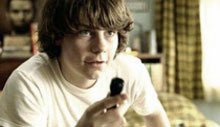Basic Teaching Techniques for Moving Images
The eight basic
techniques described on these pages are designed to
help you unravel the codes and conventions of the
moving image, and enable you to use a wider range
of film and video texts in the classroom. As you
and your pupils unpack the layers of meaning, you
will be helping them to develop their general
skills as more critical, attentive and
knowledgeable readers of the moving image.
Learning Objective
• Moving
image sound tracks can have four elements:
music, sound effects, voice and silence.
All of these contribute to meaning.
• Sound effects are of two types: ‘atmosphere’ (ie continuous sound) and ‘spot effects’ (ie short sounds).
• Sound – particularly music – can set the ‘mood’ of a text and establish its generic identity (eg comedy, thriller).
• Sound can often do more to ‘pin down’ the meaning of a sequence than visual images can.
• Sound can affect not only the way viewers interpret the images but also what they actually think they can see.
• Off-screen sounds can help to create the impression of three-dimensional space.
• Silence can also have a powerful effect on the interpretation of a sequence.
• Sound effects are of two types: ‘atmosphere’ (ie continuous sound) and ‘spot effects’ (ie short sounds).
• Sound – particularly music – can set the ‘mood’ of a text and establish its generic identity (eg comedy, thriller).
• Sound can often do more to ‘pin down’ the meaning of a sequence than visual images can.
• Sound can affect not only the way viewers interpret the images but also what they actually think they can see.
• Off-screen sounds can help to create the impression of three-dimensional space.
• Silence can also have a powerful effect on the interpretation of a sequence.
Key Questions
About music:
• What kind of music is this? What feelings/images does it suggest to you?
About sound effects:
• What exactly can you hear and what might it represent?
About words:
• What is said and what can you tell about the speaker(s) from their voice(s)?
About silence:
• Why do you think the sequence is silent at this point? What might be going on?
About the final viewing:
• What difference does the sound make to the sequence? What difference would it make if some elements were missing?
• What kind of music is this? What feelings/images does it suggest to you?
About sound effects:
• What exactly can you hear and what might it represent?
About words:
• What is said and what can you tell about the speaker(s) from their voice(s)?
About silence:
• Why do you think the sequence is silent at this point? What might be going on?
About the final viewing:
• What difference does the sound make to the sequence? What difference would it make if some elements were missing?
Sound and Image
• Cover the video screen and ask pupils to listen carefully to the sound track of a short moving image sequence and describe exactly what they hear in this sequence.• Pupils should identify the type of text they think it is and identify and describe all the sounds they can hear.
They should then guess at the content and style of the images in the sequence.
• Finally show the complete sequence and invite discussion about how sounds and images affect each other.
Possible follow-up
• Try out any or all of: different music, different sound effects, a different voice reading the same words, or different words; or eliminate any of these elements. Discuss how this affects the ways the images can be interpreted.

Image: Patrick
Fugit in Almost Famous - Text Source: Moving Images
in the Classroom. Bfi British Film Institute